Taking a customer-centric approach to plant safety
Plant engineers should “go the extra mile” to ensure the safe operation of process facilities
Workers in the bulk solids processing industries benefit when manufacturers not only develop and build the plant, but also operate it themselves. As a contract manufacturer, it’s a necessity to understand the requirements, obligations and challenges of the operator. Aspects such as product safety, fire and explosion protection, plant/operator welfare and environmental concerns must all be addressed. Based on its own practical experience, Glatt goes beyond legislative requirements to make sure that no stone remains unturned.
- authors: Frank Ohlendorf, Head of Business Support; Gerald Beck, Senior Project Manager; Sören Albers, Head of Contract Manufacturing;
Glatt Ingenieurtechnik, Bereich Process Technology Food, Feed & Fine Chemicals - originally published in the magazine CITplus, issue 9/2023, Wiley-VCH Verlag GmbH & Co. KGaA
Plant manufacturers and operators must comply with strict operational demands and legal regulations, some of which overlap or must be apportioned to the appropriate party. For the plant manufacturer, examples include conformity procedures — such as risk analyses in accordance with the Machinery Directive or the SIL (Safety Integrity Level) assessment — environmental, hygiene and infection safety, to name a few. It’s imperative that any supplied documentation and operating instructions comply with the relevant regulations.
To further develop solutions to meet existing requirements, in the interests of all stakeholders, Glatt Ingenieurtechnik (GIT) operates a modern technology centre in Weimar, Germany. For product design or the production and functionalisation of powders, granulates and pellets, customer-specific processes can be developed, tested and optimised in advance at the plant operator’s premises. This also includes certified contract manufacturing, for which the company acts as both a plant operator and bulk solids manufacturer.
Sharing experience to benefit customers
Taking a practice-based technology approach benefits both the manufacturer and the operator. This allows customers to benefit from Glatt’s many years of experience in several fields. In addition to providing solutions from optimised room concepts to complete buildings, the company is also willing to share first-hand experience on topics such as waste and environmental management, energy saving and the handling and containment of toxic and highly active substances. Product safety must also be taken into account from the outset. In the food industry, for example, and for products destined for the end consumer market, maximum safety is paramount.
This can sometimes be a sensitive issue; as a manufacturer, product liability cannot be excluded in the event of damage. The current Food Safety System Certification 22000 (FSSC), penned by the Global Food Safety Initiative (GFSI), is a good example. It implores food manufacturers to check their entire production process in terms of the hygiene conditions in the production area, the avoidance of material/microbial contamination and/or the adulteration of food. To this end, it’s important to implement robust processes in production facilities that incorporate both expertise and a sense of proportion. By doing so, it’s possible to not only optimise the quality of the plant-based operations, but throughout the entire production train as well.
Hygienic design: an attitude, not an obligation
One of the most sustainable metrics of product safety is the hygienic design of the systems involved; manufacturers should not simply rely on the application of hygienic design principles and corresponding supplier certifications. In an extensive GIT project, for example, the clean-in-place (CIP) capability of batch-based fluidised bed equipment was intensively investigated and a test system was built specifically for this purpose.
Design modifications were tested and evaluated in situ. Being a member of the EHEDG and getting involved in the creation of hygienic design guidelines for components and machines ensures the ongoing development of new initiatives in this area, as well as further training and the exchange of current thinking and ideas. This collective wisdom is shared with manufacturers and incorporated into specific plant and product hygiene practices. Consultancy and involvement in interface analysis and/or hazard and operability (HAZOP) studies — combined with inhouse operator experience — also helps with new approaches to the dust- and contamination-free handling of highly active toxic products or how to improve occupational safety during cleaning and maintenance work on fluidised and spouted bed systems.
Occupational safety taken into account, eliminating residual risks
One example is the cleaning intervals of spray nozzles. This mainly depends on the product and is indicated by deviations in particle composition. The nozzle’s inner tube is usually removed as follows: the operator first terminates the air spray at the contaminated nozzle and checks whether the safety gear (consisting of safety ropes or chains) is attached. Only then may the connecting clamp be opened and the inner tube — with the liquid insert — pulled out of the spray lance. If the inner tube is loosened during the process without interrupting the spray gas supply and without attaching the safety gear, the inner tube will shoot out abruptly owing to pressure … or cause an explosion.
If the spray unit is at head height, which is the norm with larger systems, there is a danger to life. An advanced spray nozzle safety device secures the inner pipe using a lock-and-key principle to prevent explosions and ensure that any potential operating error during nozzle disassembly has no adverse health consequences. The design of the solution consists of protected recesses and catch pins. Both elements completely eliminate risks such as the uncontrolled ejection of the inner tube. A welcome side-effect is that there is no need to clean and replace the safety chains. The explosion-proof hygienic nozzle can also be retrofitted. This is the result of many years of practical operating experience and regular risk analyses in which the status quo was scrutinised from the operator’s point of view.
Explosion protection: the safe way to bulk goods
Customers need to be able to rely on the expertise of their plant manufacturer, especially when it comes to safety. Various concepts are available for explosion protection; these should be both assessed and safeguarded by calculation, and also (ideally) confirmed in practical explosion tests. To ensure maximum plant operator safety, ignition sources should be avoided as much as possible, all machine parts should be earthed and an appropriate plant design should have been selected.
The customer can select the best concept for their needs. For example, designing a system to be pressure-resistant to 12 bar as an alternative to explosion suppression or pressure relief is eminently possible with round designs. Particularly in the case of gas explosion protection or hybrid mixtures, the investment costs can be significantly lower if you can manage without an elaborate circular gas system. However, if solvents are present in the exhaust air, gas purification by combustion or scrubbing is required.
Systems that cannot be designed and built to be pressure-resistant, such as rectangular fluidised and spouted bed systems, must be protected by either an explosion suppression system or, alternatively, an inert circulating gas (nitrogen) system (process gas). Inertisation not only provides explosion and fire protection, but can also offer additional benefits for oxygen-sensitive products. Unsaturated oils, beta-carotenes or reactive chemical substances are protected from oxidation and show better long-term stability. The advantage here is that continuous operation is possible and the solvent can be recovered. However, the investment and operating costs are higher than for fresh/exhaust air operation.
It is also possible to operate the fluidised bed under vacuum. This reduces the oxygen content below the critical limit and sensitive products are also better protected against oxidation. The boiling point is reduced by the vacuum, which enables the operator to use lower process temperatures and saves heating power and operating costs. The solvent can also be recovered.
This solution is only structurally possible with round and batch systems and the choice of solvents is limited. Another option is explosion suppression; an extinguishing agent is sprayed into the reaction chamber in the event of a pressure increase. The disadvantage is that, once triggered, the extinguishing agent cartridges have to be replaced and production is interrupted.
There are many options for application-orientated explosion protection, but the following applies to every process: it must be tailored as closely as possible to the requirements of the operator and not to the preferences of the supplier. If the plant manufacturer thinks outside the box in the interests of the customer and helps the operator to better fulfil their obligations, both sides benefit. The upshot? Profitability, process quality and safety during the production of bulk solids from the outset.
Further information on this topic and related topics can also be found in the following publications:
Glatt Technical Paper: ‘Integrated approach saves costs – Design and operation of energy-efficient fluid bed systems’. PDF, English
Glatt Technical Paper: ‘Gentle and safe processes – Drying and product design in the vacuum fluid bed’. PDF, German
Published article: ‘How to Tame Recalcitrant Ingredients with Technological Processes’ PDF, English
Published article: ‘Contract manufacturing by fluid bed and spouted bed technology: Which is better, continuous or batch process?’ PDF, English
Published article: ‚Forward-looking plant planning – How pre-engineering can bring ideas to market faster‘ PDF, English
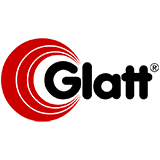

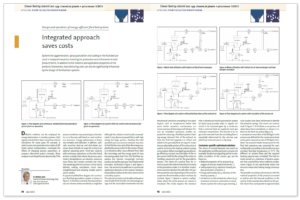
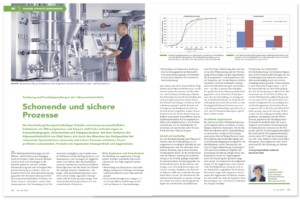
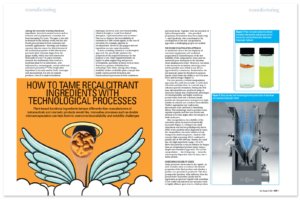
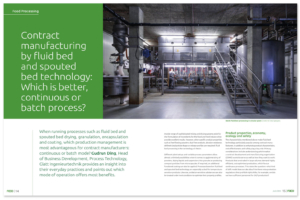

 Copyright: Glatt
Copyright: Glatt Copyright: Inter-Euro Medien
Copyright: Inter-Euro Medien